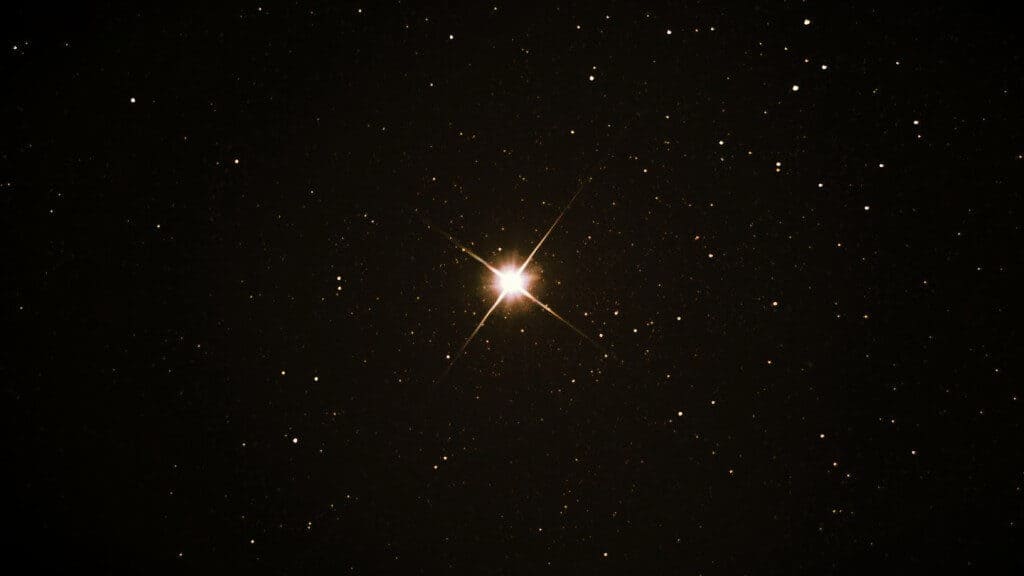Polaris, popularly known as the “North Star,” which has guided explorers for centuries, is closer than we previously thought, at just 323 light-years away. This revelation by international astronomers not only recalibrates its distance but also paves new pathways for understanding the cosmos and its hidden forces.
Location and Distance of the North Star
This celestial body, positioned in the constellation of Ursa Minor, has been the subject of fascination and meticulous study due to its nearly fixed position in the night sky, pointing directly toward the celestial North Pole.
The location and distance of the North Star have been the focus of meticulous research and recent advances in the field of astronomy. Thanks to the international collaboration of teams of astronomers in Canada, Ukraine, and Belgium, our knowledge about Polaris has experienced a remarkable evolution.
The central technique of these studies involves a detailed analysis of Polaris’s electromagnetic spectrum. This approach has allowed scientists to recalibrate the estimate of the distance between Polaris and our planet, now placing it at approximately 323 light-years from Earth.
This is a revealing piece of information, significantly altering previous conceptions that estimated this distance at 434 light-years, a figure derived from data collected in the 1990s by the European Space Agency’s Hipparcos satellite.
This adjustment in distance is not merely another astronomical fact; it represents a paradigm shift in our understanding of Polaris’s location within the cosmos. Therefore, the revised distance of Polaris provides us with a unique window into the dynamics of the cosmos, allowing us to question and expand our existing theories about the universe we inhabit.
Here, the importance of advanced technology and international collaboration in advancing astronomical science is evident. The ability to measure distances in outer space with greater precision is crucial for our understanding of astronomy and, by extension, of universal physics.
The Significance of the North Star in Astronomy
The North Star holds a place of distinction in the heavens for being the closest Cepheid variable star to the Solar System. Cepheid variables, characterized by their pulsating variability, exhibit regular and predictable changes in brightness over well-defined cycles.
This peculiarity transforms them into astronomical instruments of invaluable worth, as their behavior allows astronomers to use them as standard candles for measuring distances across the cosmic canvas.
The significance of Polaris goes beyond its proximity, residing in its essential contribution to cosmic metrology. The precise analysis of the distance to Polaris not only refines our measurement techniques of the universe but also establishes a critical framework for the detailed study of other Cepheid stars scattered across the galaxy and beyond.
This understanding deepens our capability to estimate the dimensions of the universe, facilitating a more accurate approach to the cosmic scale.
High-Resolution Anomalies and Studies
David Turner, from Saint Mary’s University in Halifax, Canada, has shed light on the complexity of Polaris by analyzing its notable anomalies, which have posed a significant challenge to the astronomical community in its efforts to interpret the nature of this star.
Despite these challenges, access to high-resolution observations of Polaris’s spectrum has marked the beginning of a promising era in the exploration of its unique features.
This meticulous approach, based on obtaining high-precision spectral data, has opened a window to a deep understanding of Polaris’s peculiarities. By analyzing these detailed observations, astronomers are now better equipped to unravel the mysteries that have surrounded this star, confronting the anomalies with an unprecedented arsenal of information and technology.
Turner’s work and his team’s efforts are particularly significant because they pave the way for broader advances in astronomy and cosmology. By revealing the secrets of Polaris, researchers may find essential clues that contribute to understanding fundamental phenomena of the universe, such as dark energy, a mysterious component that accelerates the cosmos’s expansion.
The quest for dark energy, one of the most elusive enigmas of contemporary science, could greatly benefit from findings related to Polaris. Therefore, these studies are not merely an end in themselves but a gateway to understanding the fundamental structure and fate of the universe.
Contributions to Astronomical Science
The detailed study of the variability in the brightness of Polaris and other Cepheid stars emerges as an indispensable tool in our quest to understand the universe’s dynamics, from cosmic expansion to the enigmatic distribution of matter and dark energy.
Polaris, beyond being a reference point for navigators throughout history, reveals itself as a scientific beacon illuminating our path toward a deeper understanding of the universe. This dual role underscores its invaluable worth not only in the context of navigation and orientation on Earth but also in the vast and complex journey of science toward deciphering cosmic mysteries.
With each advancement in the study of Polaris, we recalibrate not only its position in the firmament but our perspective on the universe as a whole. The proximity of Polaris, its role as the closest Cepheid, and its luminosity variability, constitute a scientific resource of immense value.
Through it, we can aspire to unravel some of the cosmos’s deepest enigmas, such as the universe’s expansion rate, the nature of dark energy, and the distribution of dark matter.
In conclusion, Polaris continues to be an object of wonder and meticulous study, standing out for its significance in science, navigation, and human cultural heritage. International collaborative efforts to investigate Polaris not only enrich our knowledge of the universe but also celebrate the spirit of exploration and global cooperation in the perpetual quest for astronomical truth.
With every discovery surrounding Polaris, we adjust not only its place in the star map but also advance our understanding of the cosmos. This Cepheid star, essential for both terrestrial navigation and astronomical exploration, continues to guide our scientific curiosity, lighting the way to new horizons of knowledge.





